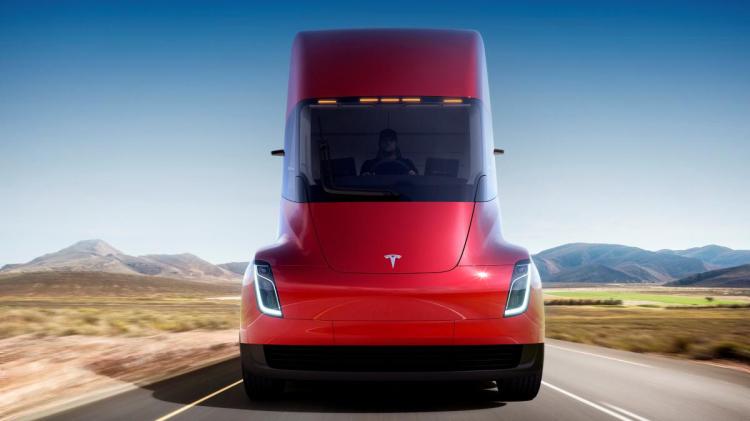Though not fully autonomous, Tesla’s electric truck that debuted in November, equipped with the company’s next-generation autopilot system, represents a significant step toward fully driverless trucks. Embark, a Silicon Valley startup, is also partnering with Ryder and Electrolux to make the trucking industry driverless. It’s an exciting technological achievement, but those of us who are members of entrepreneurial ecosystems across the Heartland need to realize that transportation is a sector of the economy where we have a strategic advantage.
Why?
Embark and Tesla might be based in Silicon Valley, but driverless trucking technology will see its most immediate use on the freeways and highways of Middle America.
VentureBeat’s Heartland Tech channel invites you to join us and other senior business leaders at BLUEPRINT in Reno on March 5-7. Learn how to expand jobs to Middle America, lower costs, and boost profits. Click here to request an invite and be a part of the conversation.
June 5th: The AI Audit in NYC
Join us next week in NYC to engage with top executive leaders, delving into strategies for auditing AI models to ensure fairness, optimal performance, and ethical compliance across diverse organizations. Secure your attendance for this exclusive invite-only event.
Besides making startup investors and founders wealthy, there is an important reason for states outside of the coasts to get in on the driverless trucking game early. The eventual and inevitable automation of trucking will have a severe impact on jobs, especially for white working-class males in rural areas. According to the American Trucking Association, more than 3.5 million people make their living as truck drivers. Close to 9 million people make their living in the trucking industry — that’s equivalent to the combined populations of Wyoming, Vermont, Alaska, North Dakota, South Dakota, Delaware, Montana, Rhode Island, Maine, and New Hampshire.
Truck driver is one of the few jobs remaining that pays decent wages to working-class Americans who lack a college degree, especially in rural communities. If you’re wondering what happens to our country when rural, working-class Americans fall behind, you need to look no further than our current toxic political environment.
Of course, the theory of creative destruction says those out-of-work drivers will be reabsorbed into the economy, but the very idea of automation and artificial intelligence is to minimize the need for human labor. In other words, it would defeat the whole point of automation if every out-of-work truck driver swapped their job behind the wheel for a job programming the software that controls autonomous trucks.
That isn’t to say that driverless trucking doesn’t have enormous economic, environmental, and safety benefits. However, just assuming the potential displacement of millions of workers will work out fine in the long run is severely misguided.
As English economist John Maynard Keynes once said, “In the long run we are all dead.”
Tech evangelists can’t have it both ways. If this era of innovation is truly revolutionary (and I believe it is), we shouldn’t look backward to understand how the massive elimination of millions of decent-paying jobs will work out. For example, while it’s true that typewriter manufacturers went out of business once the personal computer became more affordable, PC makers still required people to work in the plant.
This era isn’t just about a revolutionary change in what the economy produces. It’s about who (or what) is doing the work. Products aren’t just being replaced by superior products. Instead, humans are being replaced by machines and algorithms. The assumption that those humans will find somewhere to land, just like they did after the major tech-fueled disruptions, is wrong.
If Heartland entrepreneurial ecosystems don’t invest time and money in becoming leaders in driverless trucking, the region most dependent on trucking and the transportation of goods will see that industry and those jobs shift to Silicon Valley. The truckers who once lived in your neighborhood will be replaced by one programmer living in the Bay Area.
The loss of those trucking jobs may be inevitable, but the programmer can still call Pittsburgh or St. Louis home. Heartland cities need to seize the opportunity and become leaders in the industry before Silicon Valley claims the transportation sector for itself. Ensuring that school systems and universities are graduating students with high-level STEM skills and making autonomous vehicles and driverless cars a focus of local and state transportation policy are a start. MCity, a testing ground for autonomous vehicles at the University of Michigan, is a good example of how Heartland institutions can play an important role in developing the technology.
There’s a reason Stanford is the source of so much innovation, and it has nothing to do with being located near an ocean. Well-funded universities are essential to the success of Heartland ecosystems, and can take the lead in supporting research for emerging technology.
If autonomous semi-trucks are inevitable, the Heartland should start preparing for that job loss now. Ignoring a potential employment, sociological, and political disaster — or, alternatively, assuming that things will be OK in the long run simply because they have been in the past — is dangerous. But before you can solve a problem, you need to accurately diagnose it.
The reality is that the coming era of job loss will be different than anything we’ve seen before, simply because so much current innovation is focused on reducing or eliminating human labor. And the recognition that this time really is different will be the first step to figuring out how we will handle the loss of millions of jobs, and not just in the trucking industry.
Dustin McKissen is an economic development executive in the greater St. Louis area, a LinkedIn Top Voice on Management and Culture, a CNBC contributor, and an Inc. columnist.

